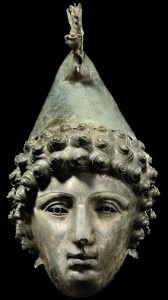 The exceptional bronze cavalry helmet and face mask discovered by a metal detectorist in the Cumbrian hamlet of Crosby Garrett is finally on display at its home museum, the Tullie House Museum in Carlisle, Cumbria.
The exceptional bronze cavalry helmet and face mask discovered by a metal detectorist in the Cumbrian hamlet of Crosby Garrett is finally on display at its home museum, the Tullie House Museum in Carlisle, Cumbria.
You may recall the tragic tale of how a priceless, unique, internationally important ancient Roman helmet fell through a gaping loophole in the UK’s Treasure Act to be sold to an anonymous private collector. A summary for those of you who missed the story the first time around: the helmet was found in 67 pieces in May of 2010. The Treasure Act of 1996 requires finders of historical artifacts to report the discovery so that a coroner’s inquest can establish if the object is legally treasure. Treasure is defined here as all coins in a hoard that are 300 years old or older, two or more prehistoric objects made out of base metal, any non-coin object that is at least 300 years old and composed of at least 10% gold or silver, and gold and silver artifacts less than 300 years old with no known owners or heirs of owners. If the object qualifies as treasure, the finder must sell it to a local museum for fair market value as determined by the Treasure Valuation Committee, usually experts at the British Museum, and split the proceeds with the landowner. If not, it can be sold to whomever.
So, two silver coins from 1700 are treasure, even though there may be thousands of them in private and public hands, but a bronze Roman cavalry helmet, even though it’s one of a kind, painfully beautiful and invaluable to historians and archaeologists, is not. The Crosby Garret Helmet was declared non-treasure, and therefore the finder and landowner could do whatever they wanted. They wanted to make as much money as humanly possible, so the helmet went to Christie’s where its experts put 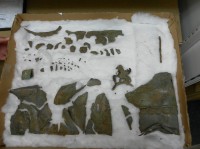 the pieces back together, a highly controversial “restoration” since no archaeologists were allowed to examine the helmet in its original context and condition and the aim was to make it look great for sales purposes, not to conserve it according to rigorous archaeological standards. Very 18th century.
the pieces back together, a highly controversial “restoration” since no archaeologists were allowed to examine the helmet in its original context and condition and the aim was to make it look great for sales purposes, not to conserve it according to rigorous archaeological standards. Very 18th century.
Christie’s set expectations low with its frankly absurd pre-sale estimate of £200,000 – £300,000 ($318,400 – $477,600). Everyone knew it was going to sell for far more than that. The Tullie House Museum raised an incredible £1.7 million from big ticket donors and thousands of Cumbrians anxious to keep this artifact where it was found, but after just four minutes of intense bidding, the helmet sold to an unknown party for £2,281,250 ($3,629,469). Despite multiple attempts to contact the helmet’s owner to arrange a private sale or even just a chance to take detailed measurements so a replica could be made for display, the Tullie House Museum had to take solace in the support of other museums which loaned them beautiful consolation prizes for the opening of the new Roman gallery in 2011.
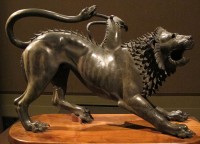 The helmet’s still-anonymous owner seems to have loosened up since then. In fall of 2012, the Crosby Garret Roman Helmet went on public display for the first, and until now only, time at the Royal Academy of Art’s Bronze exhibition where it stood proudly amidst some of the greatest bronze pieces ever made, like the Etruscan Chimera of Arezzo. Now it’s finally Tullie House’s turn. It went on display yesterday, November 1st, and will remain at Tullie House until January 26th, 2014. After that, it moves to the British Museum where it will go on display starting February 3rd, 2014.
The helmet’s still-anonymous owner seems to have loosened up since then. In fall of 2012, the Crosby Garret Roman Helmet went on public display for the first, and until now only, time at the Royal Academy of Art’s Bronze exhibition where it stood proudly amidst some of the greatest bronze pieces ever made, like the Etruscan Chimera of Arezzo. Now it’s finally Tullie House’s turn. It went on display yesterday, November 1st, and will remain at Tullie House until January 26th, 2014. After that, it moves to the British Museum where it will go on display starting February 3rd, 2014.
It will be in good company there. Only three cavalry helmets with face masks have been found in the UK: the Crosby Garret, the Newstead Helmet, found in Newstead, Roxburghshire, Scotland in 1905, and the Ribchester Helmet. The Ribchester Helmet was discovered in 1796 by the son of clogmaker Joseph Walton in Ribchester, Lancashire, along with a hoard of cavalry fittings and is now in the permanent collection of the British Museum. Also at the British Museum is the second century bronze cavalry parade mask of a woman’s face, perhaps representing an Amazon, found in tomb at Nola, near Naples. Her ring eyes are very reminiscent of Crosby Garret’s.
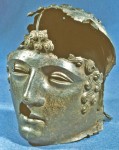
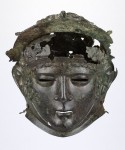
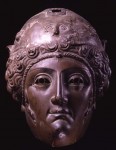
These unsettlingly beautiful visages were not deployed on the battlefield nor do they appear to have been military issue. They were owned by individual soldiers for use in cavalry sports events. The Greek historian Arrian of Nicomedia wrote about the hippika gymnasia in chapter 34 of Ars Tactica, a report on military tactics he prepared for his friend and emperor Hadrian. I wasn’t able to find a translation of the original Greek online, but this book quotes the relevant passage:
The horsemen enter [the exercise ground] fully armed, and those of high rank or superior in horsemanship wear gilded helmets of iron or bronze to draw the attention of the spectators. Unlike the helmets made for active service, these do not cover the head and cheeks only but are made to fit all round the faces of the riders with apertures for the eyes … From the helmets hang yellow plumes, a matter of decor as much as of utility. As the horses move forward, the slightest breeze adds to the beauty of these plumes. They carry oblong shields of a lighter type than those used in action, since both agility and smart turnout are the objects of the exercise and they improve the appearance of their shields by embellishment. Instead of breastplates the horsemen wear tight leather jerkins embroidered with scarlet, red or blue and other colours. On their legs they wear tight trousers, not loosely fitting like those of the Parthians and Armenians. The horses have frontlets carefully made to measure and have also side armour.
Someone needs to reenact a cavalry battle between masked Amazons and Phrygians because it sounds like an amazing spectacle.